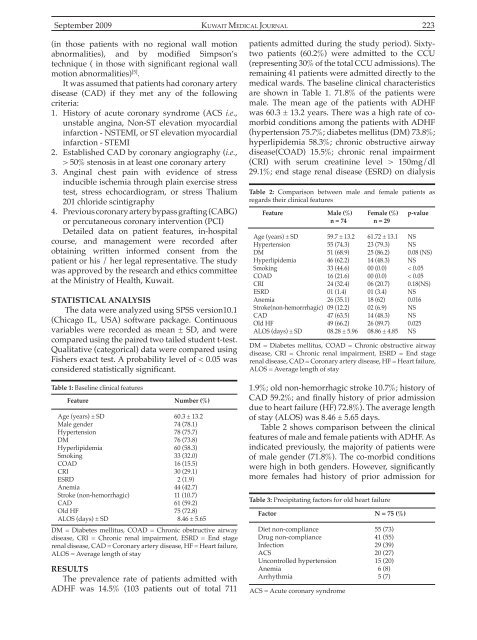Vol 41 # 3 September 2009 - Kma.org.kw
Vol 41 # 3 September 2009 - Kma.org.kw
Vol 41 # 3 September 2009 - Kma.org.kw
Create successful ePaper yourself
Turn your PDF publications into a flip-book with our unique Google optimized e-Paper software.
<strong>September</strong> <strong>2009</strong><br />
KUWAIT MEDICAL JOURNAL 223<br />
(in those patients with no regional wall motion<br />
abnormalities), and by modified Simpson’s<br />
technique ( in those with significant regional wall<br />
motion abnormalities) [5] .<br />
It was assumed that patients had coronary artery<br />
disease (CAD) if they met any of the following<br />
criteria:<br />
1. History of acute coronary syndrome (ACS i.e.,<br />
unstable angina, Non-ST elevation myocardial<br />
infarction - NSTEMI, or ST elevation myocardial<br />
infarction - STEMI<br />
2. Established CAD by coronary angiography (i.e.,<br />
> 50% stenosis in at least one coronary artery<br />
3. Anginal chest pain with evidence of stress<br />
inducible ischemia through plain exercise stress<br />
test, stress echocardiogram, or stress Thalium<br />
201 chloride scintigraphy<br />
4. Previous coronary artery bypass grafting (CABG)<br />
or percutaneous coronary intervention (PCI)<br />
Detailed data on patient features, in-hospital<br />
course, and management were recorded after<br />
obtaining written informed consent from the<br />
patient or his / her legal representative. The study<br />
was approved by the research and ethics committee<br />
at the Ministry of Health, Kuwait.<br />
STATISTICAL ANALYSIS<br />
The data were analyzed using SPSS version10.1<br />
(Chicago IL, USA) software package. Continuous<br />
variables were recorded as mean ± SD, and were<br />
compared using the paired two tailed student t-test.<br />
Qualitative (categorical) data were compared using<br />
Fishers exact test. A probability level of < 0.05 was<br />
considered statistically significant.<br />
Table 1: Baseline clinical features<br />
Feature Number (%)<br />
Age (years) ± SD 60.3 ± 13.2<br />
Male gender 74 (78.1)<br />
Hypertension 78 (75.7)<br />
DM 76 (73.8)<br />
Hyperlipidemia 60 (58.3)<br />
Smoking 33 (32.0)<br />
COAD 16 (15.5)<br />
CRI 30 (29.1)<br />
ESRD 2 (1.9)<br />
Anemia 44 (42.7)<br />
Stroke (non-hemorrhagic) 11 (10.7)<br />
CAD 61 (59.2)<br />
Old HF 75 (72.8)<br />
ALOS (days) ± SD 8.46 ± 5.65<br />
DM = Diabetes mellitus, COAD = Chronic obstructive airway<br />
disease, CRI = Chronic renal impairment, ESRD = End stage<br />
renal disease, CAD = Coronary artery disease, HF = Heart failure,<br />
ALOS = Average length of stay<br />
RESULTS<br />
The prevalence rate of patients admitted with<br />
ADHF was 14.5% (103 patients out of total 711<br />
patients admitted during the study period). Sixtytwo<br />
patients (60.2%) were admitted to the CCU<br />
(representing 30% of the total CCU admissions). The<br />
remaining <strong>41</strong> patients were admitted directly to the<br />
medical wards. The baseline clinical characteristics<br />
are shown in Table 1. 71.8% of the patients were<br />
male. The mean age of the patients with ADHF<br />
was 60.3 ± 13.2 years. There was a high rate of comorbid<br />
conditions among the patients with ADHF<br />
(hypertension 75.7%; diabetes mellitus (DM) 73.8%;<br />
hyperlipidemia 58.3%; chronic obstructive airway<br />
disease(COAD) 15.5%; chronic renal impairment<br />
(CRI) with serum creatinine level > 150mg/dl<br />
29.1%; end stage renal disease (ESRD) on dialysis<br />
Table 2: Comparison between male and female patients as<br />
regards their clinical features<br />
Feature Male (%) Female (%) p-value<br />
n = 74 n = 29<br />
Age (years) ± SD 59.7 ± 13.2 61.72 ± 13.1 NS<br />
Hypertension 55 (74.3) 23 (79.3) NS<br />
DM 51 (68.9) 25 (86.2) 0.08 (NS)<br />
Hyperlipidemia 46 (62.2) 14 (48.3) NS<br />
Smoking 33 (44.6) 00 (0.0) < 0.05<br />
COAD 16 (21.6) 00 (0.0) < 0.05<br />
CRI 24 (32.4) 06 (20.7) 0.18(NS)<br />
ESRD 01 (1.4) 01 (3.4) NS<br />
Anemia 26 (35.1) 18 (62) 0.016<br />
Stroke(non-hemorrrhagic) 09 (12.2) 02 (6.9) NS<br />
CAD 47 (63.5) 14 (48.3) NS<br />
Old HF 49 (66.2) 26 (89.7) 0.025<br />
ALOS (days) ± SD 08.28 ± 5.96 08.86 ± 4.85 NS<br />
DM = Diabetes mellitus, COAD = Chronic obstructive airway<br />
disease, CRI = Chronic renal impairment, ESRD = End stage<br />
renal disease, CAD = Coronary artery disease, HF = Heart failure,<br />
ALOS = Average length of stay<br />
1.9%; old non-hemorrhagic stroke 10.7%; history of<br />
CAD 59.2%; and finally history of prior admission<br />
due to heart failure (HF) 72.8%). The average length<br />
of stay (ALOS) was 8.46 ± 5.65 days.<br />
Table 2 shows comparison between the clinical<br />
features of male and female patients with ADHF. As<br />
indicated previously, the majority of patients were<br />
of male gender (71.8%). The co-morbid conditions<br />
were high in both genders. However, significantly<br />
more females had history of prior admission for<br />
Table 3: Precipitating factors for old heart failure<br />
Factor N = 75 (%)<br />
Diet non-compliance 55 (73)<br />
Drug non-compliance <strong>41</strong> (55)<br />
Infection 29 (39)<br />
ACS 20 (27)<br />
Uncontrolled hypertension 15 (20)<br />
Anemia 6 (8)<br />
Arrhythmia 5 (7)<br />
ACS = Acute coronary syndrome
















